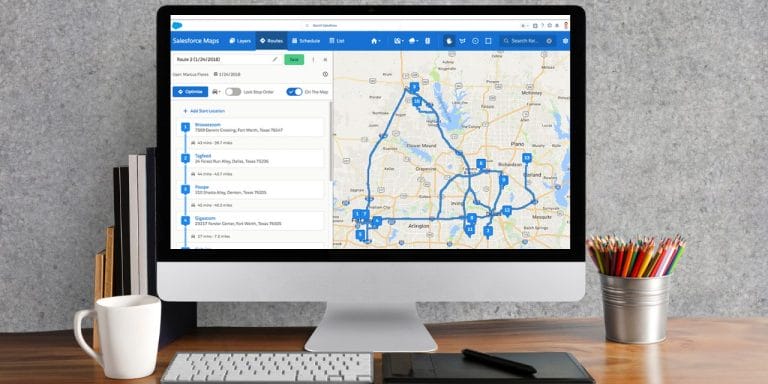Looking to improve your sales management process? Read on.
Sales management describes the full spectrum of activities that help companies maximize the value of their sales team. This process includes everything from hiring, training, and supporting the sales staff to coordinating operations, implementing a cohesive strategy, and measuring sales performance.
Sales management organizes these activities into four main buckets; sales strategy, sales operations, sales analysis, and sales training.
Altogether, the sales management process serves as a framework that brings all sales activities, training & development programs, recruitment strategies, and reporting processes into alignment.
In this article, we’ll explain how to develop a sales management process in 16 steps, broken down by category.
Why is Sales Management Important?
According to the Sales Management Association, 90% of companies with formalized sales processes in place were top-performers in their respective markets.
A well-defined sales management process ensures that strategy, training, operations align with the business’ high-level objectives, which in turn, provides the following benefits:
– Maximizes conversion rates
– Increases deal size
– Speeds up the sales cycle
– Improves forecasting accuracy
The point is, it doesn’t matter what you sell: if your company relies on a team of reps to drive revenue, then you need a sales management process.
Planning & Operations
Sales operations is a term that describes the activities and processes within a sales organization that support and enable sales teams to be successful and stay aligned with the business’ big-picture strategies and objectives.
This part of the sales management process aims to create a foundation that supports salespeople to effectively do their jobs.
That means hiring the right people, setting targets, and establishing a compensation structure that incentivizes sellers to focus on continuous improvement.
Additionally, tasks like managing an asset library full of sales collateral, assigning territories, setting targets, and defining the KPIs that measure success.
Essentially, you’re putting all the pieces in place so that you can carry out your sales strategy.
1. Hire a Team
If you’re building a sales team from scratch, the best place to start is with your customers.
– What does their buying process like?
– How many people are involved in making the purchasing decision?
– What obstacles might those decision-makers encounter during their journey?
You’ll then want to look at your business strategy to determine how buyer goals align with your organizational objectives.
Once you’ve established some criteria around who your ideal customer is and how your sales process aligns with your big-picture goals, you’ll want to then come up with a job description that clearly defines the responsibilities that come with the territory and how they align with your big-picture goals.
We also recommend including information about your company–particularly your organization’s mission and values–as this can help attract candidates that align with those core values.
Sales has a notoriously high turnover rate so making sure you find the right people is essential for putting together a team that sticks around for the long-haul.
2. Establish Compensation Structure
Before you publish a job posting, you’ll want to develop a clearly-defined compensation plan. After all, most reps aren’t going to accept a job until they know how much money they’ll be making.
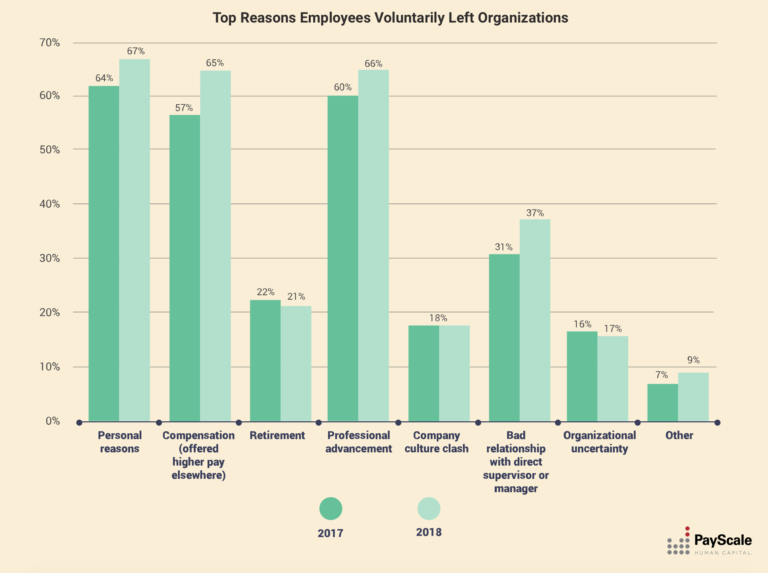
A compensation plan should include base pay, commission, and other incentives they may be eligible for based on their performance. Download our sample commission calculators here.
Remember, the goal of a compensation plan is to encourage positive behaviors that drive results for your company.
Factors to consider as you put together your compensation structure:
– What’s your budget?
– How much do your competitors offer their reps?
– What are your organizational goals?
In a recent post, we broke down eight types of commission structures, weighing pros, cons, and when to use each one. We also mention that more money doesn’t always lead to better performance.
3. Set Targets
Sales targets represent the number of sales or amount of revenue that a sales manager determines a rep should hit within a specific amount of time.
In other words, how much money do you expect reps to bring in each month/quarter/year?
Make sure you set realistic targets by looking at your current average close rate as a starting point.
From there, you’ll want to determine how much each rep needs to sell to maintain that average, then set the bar a bit higher. For example, if each rep needs to close 10 deals to break even, you might set the quota at 15, giving you a bit of wiggle room.
That said, avoid setting targets too high, you want to keep sellers motivated by challenging them and setting them up for success.
4. Establish Goals and KPIs
Key performance indicators (KPIs) track your performance against your business goals. To set the stage for success, you’ll need to determine which KPIs are most relevant to your industry and strategic goals, as focusing on the wrong metrics can actively damage your brand and bottom line.
Common KPIs include:
– Conversion rates
– Average sales cycle length
– Number of deals in the pipeline
– Pipeline value
– MQL to SQL conversion rate
– Customer lifetime value
– Sales by territory
The list goes on, however, the key thing to keep in mind here is, the KPIs you choose should come together to help you track progress toward a specific goal–otherwise, they’re just vanity metrics.
5. Build a Sales Stack
You’ll want to enable your sales team with the right tools for getting the job done.
Tools vary by organization and are determined by a number of factors including whether your reps do inside or outside sales, how many territories you sell to, whether you work with affiliates or network partners, etc.
That said, on a basic level, technology should support the activities associated with each pipeline stage, and integrate with your CRM so that reps always have the most accurate view of their target prospects or accounts. This will enable outside sales reps to maximize productivity, and provide managers with greater visibility into what’s happening in the field.
6. Assign Territories
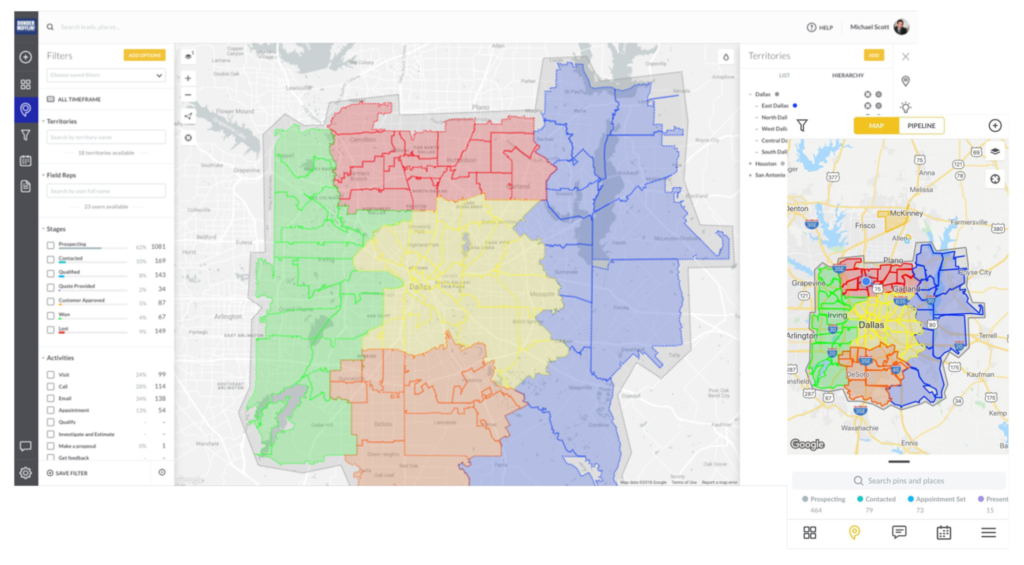
Assigning sales territories with the SPOTIO territory manager.
You’ll want to make sure you place top-performers in your most profitable regions to maximize revenue. At the same time, you’ll also want to ensure that all reps have enough prospects and leads to work with, and that their territories don’t overlap with other sellers.
We explain it in more detail here, but territory mapping allows sales leaders to ensure reps cover the right areas, demographics, and ideal prospects.
Strategy & Process
There are some things you can’t control. And unfortunately, results are one of them.
Once you’ve assembled your team and identified your targets, your goal is to gain as much control over the “intangibles” as possible to maximize wins and bring in a predictable revenue stream.
Your sales process will define how you’ll set up the stages in your sales funnel, and outlines the methods that your reps will use to take deals from start to finish.
Sales managers rely on sales forecasting to set quotas, using historical data as the basis for big-picture goals. They also spend a large chunk of time coming up with the best strategies for meeting sales objectives, which often means selecting the tactics most likely to yield the desired outcome.
7. Choose a Model
First, you’ll want to choose a model for your sales management process.
There are three common models, which break down as follows.
Island. The island leaves sellers largely on their own, with minimal structure, and a handful of basic tech and information they need to do their job. Traditionally, the island approach is relatively hands-off and is more competitive than collaborative.
While some reps thrive in this environment, and it’s easy to attribute wins to individuals, it’s also really challenging to ensure that reps stick to the script.
Assembly line. The assembly line model is a team-based model where each rep specializes in a specific part of the sales cycle. For example, some reps focus on lead generation, others handle prospecting, presentations, or swoop in at the end to close the deal.
The benefit here is, the assembly line allows reps to really master a specific set of skills, it’s easy to identify and fix problems, and it can be a really efficient way to get results.
At the same time, it requires a large team and can contribute to silos and inconsistent experiences, as buyers deal with different people at different stages in the process.
Pod. In the “pod” model, the sales force is divided into a series of small teams or pods. Each pod is assigned a specific customer type.
The pod is similar to the assembly line approach, as each rep is assigned to a particular stage in the sales process. The difference is, the pod approach is more customer-centric and focuses on developing a team of close-knit, highly-specialized sellers who work exclusively with a single customer segment.
This model works best for organizations with long sales cycles, particularly those that follow an account-based marketing approach.

(Source)
8. Define Pipeline Stages
The sales pipeline is a visual tool for understanding where prospects are in the sales process. Each stage represents a prospect’s progress on their journey from lead to customer.

Image: SPOTIO report showing the conversion rate between each stage in the pipeline for a field sales team.
Every organization has a unique approach to selling, and its sales pipeline should be designed to reflect that. However, there are some core similarities that remain consistent across the board.
For example, no matter what you sell, you’ll need a system for identifying, qualifying, and engaging prospects. You’ll also need a set of strategies that determine how to best nurture prospects and reliably close the deal.
As such, most sales pipelines follow a basic framework that includes the following four stages, though some choose to add more.
– Prospecting
– Qualification
– Proposal
– Closing
Ultimately, the most important thing to remember is that your pipeline stages must be clearly defined.
When one stage bleeds into the next, the pipeline loses its power as an effective tool for managing the sales process.
9. Align Sales Activities with Pipeline Stages
Sales activities represent the controllable elements in your sales process. These are the things that sales reps will do each day, at each stage of the pipeline, to keep deals moving forward, and may include any of the following:
– Prospecting
– Contacts – # phone calls, emails, on-site visits, social media connections every day with prospects to turn them into leads.
– Follow up/ referral requests/ upsells
– Presentations/ quotes delivered
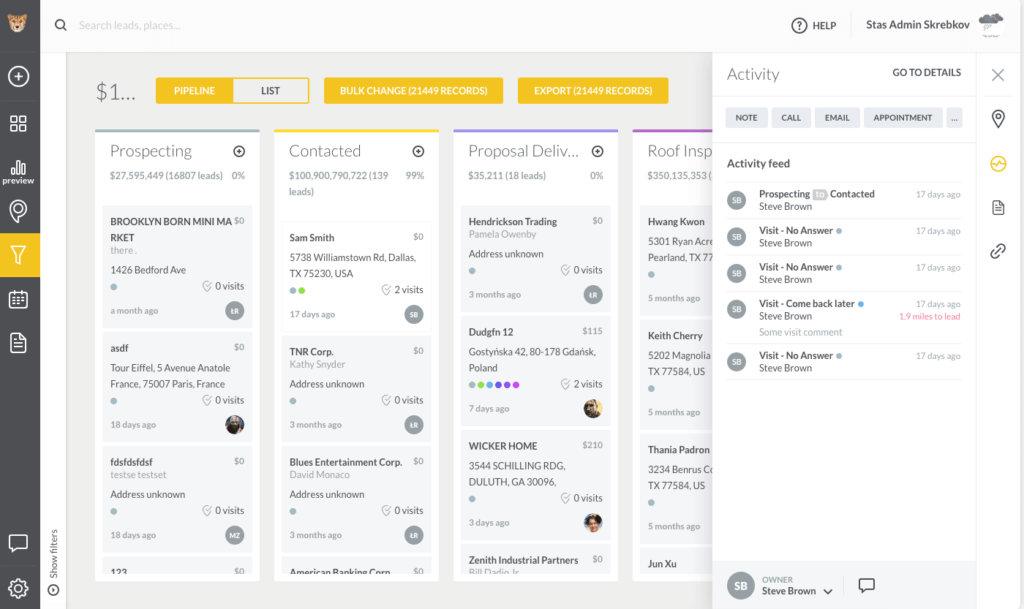
You should also customize the pipeline stages based on your industry. Eg: in the screenshot above a user has created a stage titled “Roof Inspected”.
Once you’ve defined the activities you’ll use at each stage, you’ll need to develop playbooks for each activity. Playbooks should offer clear expectations around best practices for performing these activities, as well as provide recommendations for how many emails to send or cold calls to make each day, based on historical performance data.
For example, how many times do you need to reach out to a prospect to turn them into a qualified lead? Or, how many follow-ups does it take to book a demo?
10. Set Territories
Okay, we already mentioned territory assignments, but you’ll want to revisit this area again as you develop your strategy. This time around, you’ll want to make sure you get the most from your resources.
Use territory management software to identify viable accounts in each reps’ territory, optimize meeting schedules and routes, and redesign territories to keep pipelines topped up.
11. Forecast Performance
Sales forecasting is the process of estimating future sales based on historical data.
More specifically, forecasting refers to the ability to predict what the sales team, individual, or company will sell weekly, quarterly, or annually.
Sales managers use sales forecasts to anticipate how much revenue their team will bring in over a certain period, as well as identify potential issues in advance.
That way, organizations can come up with a contingency plan to mitigate potential damage to the bottom line.
For example, if you find that your team is trending 20% below their sales targets, you can do some digging to find out what went wrong and take action.
Maybe your competitor has started an aggressive new discounting campaign, your sales team is wasting time looking for content to send buyers, or your compensation plan doesn’t inspire much action.
The ability to unearth these types of problems early on can save your organization from major losses down the line and prevent sellers from developing bad habits that get in their way.
Forecasting also factors into a number of critical decisions from resource planning to budgeting, quota-setting, and hiring new talent.
Measurement & Reporting
Next, you’ll need to come up with a strategy for measuring your efforts.
Reporting allows you to understand how your current approach impacts your company’s success and provides insight into what you can do to improve your results—whether that’s streamlining the sales process, hiring new reps, or providing hands-on coaching to struggling sellers.
While every organization tracks a different set of metrics, at a minimum, the reporting process should include two main categories—activity metrics and pipeline metrics.
Here’s a quick breakdown of what each category measures.
12. Track Activity Metrics
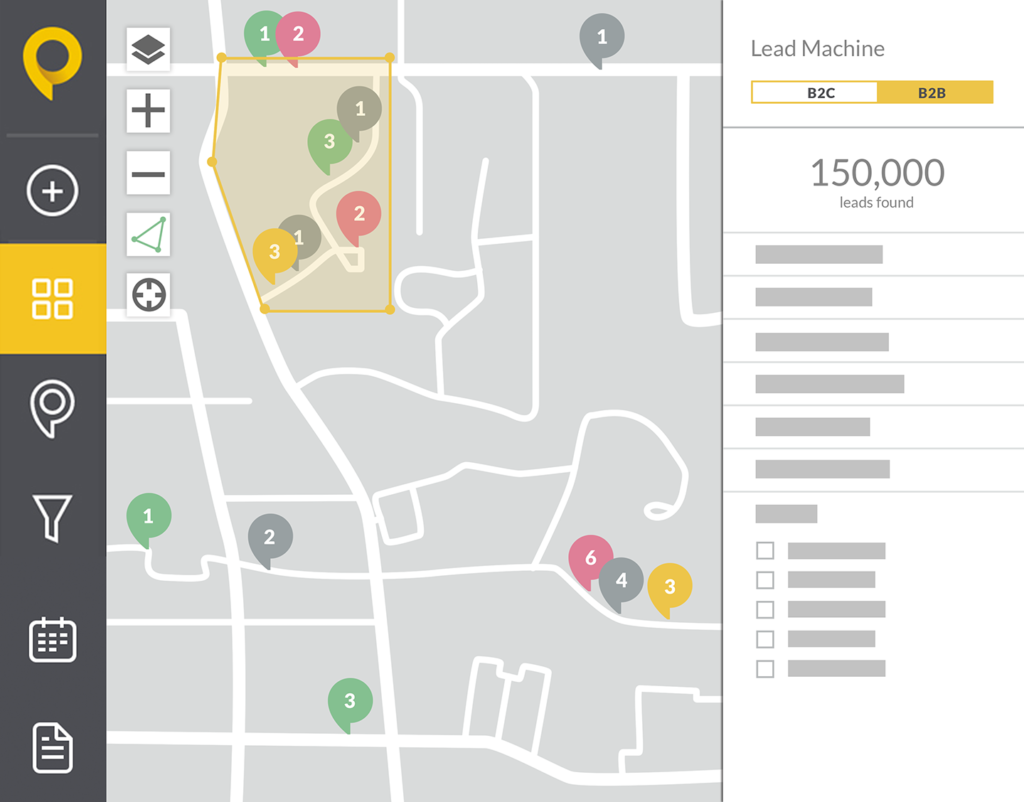
Image: SPOTIO Sales Leaderboard showing top-performing reps by activity count.
Sales activity metrics reveal what salespeople are doing on a daily basis and typically include the following:
– Number of leads created
– Number of emails sent
– Number of calls made
– Number of meetings booked
– Number of conversations with prospects
– Number of social media interactions
– Number of proposals sent
– Number of demo presentations
Keep in mind, activity metrics are often misused and misunderstood. As a manager, you’ll need to make sure that you clearly define these “what” and “how many” metrics in a way that drives the outcomes you’re looking for.
While sales leaders can’t control the execution of these activities, they can look at individual productivity metrics and outcomes. Then from there, they might use those insights to develop individual improvement plans.
For a deeper dive into activity metrics and their role in the sales process, check out this recent post.
13. Review Pipeline Metrics
Pipeline metrics look at the sales process and aim to identify the strengths and weaknesses of each stage in the sales funnel.
If you keep a close eye on these metrics, you’ll have a solid idea of how your team is performing. Where activity metrics measure “what” sellers do all day, pipeline metrics measure the impact of those activities.
Pipeline metrics include:
– Length of sales cycle
– Conversion rate
– Win rate
– Average deal size
– Open opportunities
– Closed opportunities
Each of these metrics can provide insight into sellers’ performance, allowing you to tweak and optimize your approach to drive better outcomes.
Building sales reports doesn’t have to be tedious and time-consuming. SPOTIO’s My Reports feature makes it quick and easy for field sales managers to generate customized reports that only include the metrics that matter most to your organization.
Training
The last part of an effective sales management process covers all things training and professional development. Here, the focus is on recruiting, hiring, and onboarding the right people, then long-term, providing effective training and development opportunities.
14. Develop Essential Sales Skills
Coaching and developing the sales team is increasingly becoming a more important part of any sales manager’s job. Leaders must model effective sales techniques and help reps overcome weaknesses. Ongoing training should focus on sharpening critical sales skills like prospecting and giving a demo, as well as build on existing knowledge.
15. Improve the Customer Experience
As sales becomes increasingly customer-centric, sellers must learn to present tailored solutions to each prospect. Your training program should focus on how to identify buyer-specific needs and help them achieve their goals at each stage in the pipeline.
16. Use Data to Refine the Sales Process
Use the reporting to isolate issues in the sales process–be it on the individual or team level, and then use your findings to come up with a corrective action plan. For managers working with remote or distributed teams, tools like video and 1:1 chat can help drive improvements from anywhere.
How Technology Improves the Sales Management Process
Some people initially opt for excel spreadsheets and sticky notes, and while any documentation is a step in the right direction, you’ll need to make sure you have the right tools in place for managing your sales process from all angles.
A sales engagement platform allows you to bridge the gap between planning, process, and performance.
There are a lot of features to consider while evaluating sales engagement technologies; however, here’s a quick rundown of some of the essential capabilities you’ll want to look out for.
Prospecting. Enable reps to prospect with residential and/or commercial ideal customer profile data – business type, revenue, credit capacity, home ownership vs. renting etc – and avoid wasting time on unqualified prospects.
Activity Tracking. Make sure reps are logging their activities, and hitting the minimum daily sales activities you set.
Multichannel Engagement. You’re going to need to connect with potential buyers across multiple channels. This can get messy fast.
Task and process automation. Your sales stack should minimize the amount of time reps spend on tedious admin tasks such as CRM data entry, and also automate key steps in the sales process, such as lead follow up.
Document Management. Document management solutions make it easy to ensure sales content remains compliant and on-brand, while at the same time, allows reps to send personalized collateral to individual prospects.
Territory Management. Divvy up the resources and make sure your top talent is working in the most valuable territories.
Pipeline Reporting. Keep track of deals at each stage of the pipeline to understand the efficiency and value created by reps.
Streamline Your Sales Management Process
Developing, implementing, and maintaining a sales management process is no easy task.
From prospecting and productivity to intelligent reporting, SPOTIO’s sales management solutions help sales leaders engage teams, gain real-time pipeline visibility, and keep all of these moving pieces organized and aligned toward the right goals.
Check out SPOTIO’s features to see how we can help.
_____________





